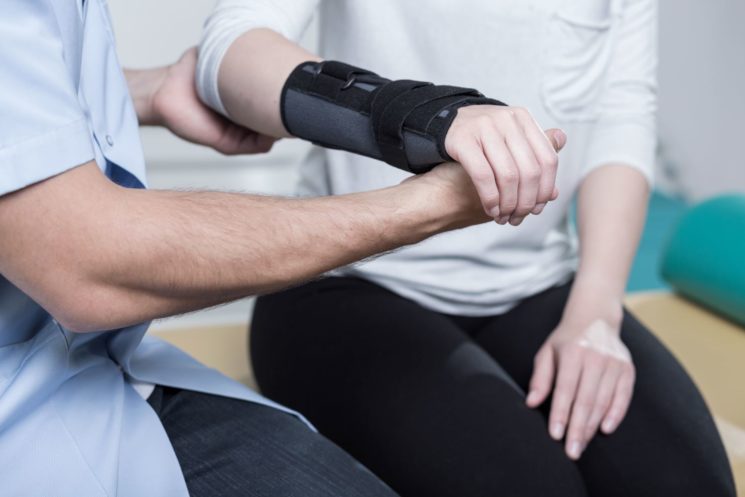The pelvic floor muscles provide support around your bladder, bottom, and vagina. One of their key functions is to support bladder and bowel control and sexual function.
Pelvic floor muscles support a healthy continence, giving you control over when you go to the bathroom. By keeping and maintaining strength in your pelvic floor, you help to maintain healthy blood flow and nerve supply. They also help maintain stability and keeping good posture.
If your pelvic floor muscles are weak, you may find that you leak urine when you cough, sneeze, or strain. This is quite common, especially for women who have just given birth, and there is no reason to feel embarrassed if it does happen to you. However, there are simple exercises which can help.
Lucie O'Shaughnessy, Women's Health Physiotherapist, Basinghall Clinic, outlines these and answers the top questions on pelvic floor.
Exercises to improve your pelvic floor
- Sit in a chair with your feet flat on the floor and your knees hip distance apart.
- Find your ‘neutral’ spine. To do this, imagine your pelvis is a bucket of water. Spill the bucket backward flattening your back, then spill the bucket forward creating an arch in your lower back. Move through this pelvic tilt until you find middle point between these two positions. This is your ‘neutral’ spine position.
- Inhale to prepare, then exhale slowly imagining you are stopping wind coming out of your back passage and then lifting from your front passage (as if you were trying to stop urinating).
- Finding your deep abdominals - place your hands under your lower tummy, inhale to prepare, exhale slowly, and tighten your deep abdominals by drawing your lower tummy away from your hands a little (as if you were to zip up your trousers).
- Hold both pelvic floor muscles and deep abdominals for as long as you can. Aim for 10 lifts and squeezes with duration of 10 seconds or whatever you can do. Relax in between for 4-5 seconds making sure you relax fully. Gradually build up on how long and how many repetitions you can do. These exercises that can then be progressed to sub-maximal hold of 20-30 seconds depending on the persons need.
- As well as this, you need to do short bursts of 1-2 second holds followed by 1-2 second relaxation 10 times.
- Aim to do your pelvic floor exercises daily.
- Remember: keep breathing into your stomach (instead of only your chest) and try not to tighten your stomach, thighs or bottom.
What can I do to help my pelvic floor before I give birth?
For pregnant women, training the pelvic floor muscles will help their body support the weight of their growing baby. It will also help muscles recover more easily once the baby is born.
It’s a good idea for most pregnant women to consider pelvic floor exercises, even if they’re young and not suffering from stress incontinence now. If wondering whether you can exercise, speak with your healthcare professional who will be able to advise what exercises you can complete, if any. It is important that you keep active throughout your pregnancy and keep up with your other exercise alongside pelvic floor and deep abdominal exercises like swimming, walking, and Pilates for example.
What exercises can pregnant women do?
- minimum of 150 mins of moderate exercise per week
- start gradually if you weren’t previously active and try to keep up your exercise if you were
- adapt exercises to suit your ability, especially as your pregnancy progresses
- listen to your changing body and adapt what you can do like run then walk when at later stages of pregnancy
- do strengthening exercises twice per week
- every activity counts, every minute counts. Even small things can add up
- limit exercise to 45 minutes, stay well hydrated and exercise in a cool room, avoid peak periods of sun/heat during the day if you are going for a walk
What exercises should I be doing now I’ve given birth?
The same exercises can be done as the ones above. Do as much as you can as often as you can. You might find fatigue and lack of sleep makes them harder to do, so try fitting them around other activities, for example, during breastfeeding your baby.
When should I start my pelvic floor exercises?
Start as soon as you feel comfortable and as long as you don’t have any pain. If you had C-section you might wait till your scar healed and it’s not too sore. You can practice these lying down, sitting or standing.
Continue doing these for few months. If you find you are still leaking urine after 12-16 weeks, it would be a good idea to visit your GP or women’s health physiotherapist for advice and treatment.
I have started leaking urine even though I gave birth years ago
There is no right or wrong time to start doing your pelvic floor exercises, even years after giving birth. If you do have symptoms, it is recommended that you consult a women’s health physiotherapist, who can give you guidance on the specific tailor-made pelvic floor exercises, to suit your own individual pelvic floor needs.
The onset of menopause can cause your pelvic floor muscles to weaken. It is not unusual for pelvic floor symptoms to develop like stress urinary incontinence. The weakening of these muscles can result in pelvic floor problems. Reduced pelvic floor muscle function around the time of menopause can also be due to weight gain, which is common during menopause.
Other factors that can heighten the chances of pelvic floor dysfunction later down the line are trauma resulting from childbirth and chronic conditions such as diabetes or asthma which can cause bladder or bowel control problems.
The recommended guidelines advise a course of pelvic floor strengthening before any other treatments, if there is limited improvement after around three months of completing these exercises, then a referral to a urologist or gynaecologist is recommended for other treatment options such as surgery.
Why choose us?
At Cromwell Hospital, we offer specialised expertise and personalised guidance to address your unique needs.
- Leading consultants: Our skilled healthcare professionals are well-versed in pelvic floor health, ensuring you receive the highest quality care.
- Comprehensive approach: We take a holistic view of your wellbeing, combining medical insights with lifestyle recommendations for lasting pelvic floor improvements.
- Leading-edge resources: Our state-of-the-art facilities and advanced technologies empower us to provide you with the latest, most effective treatments available.



